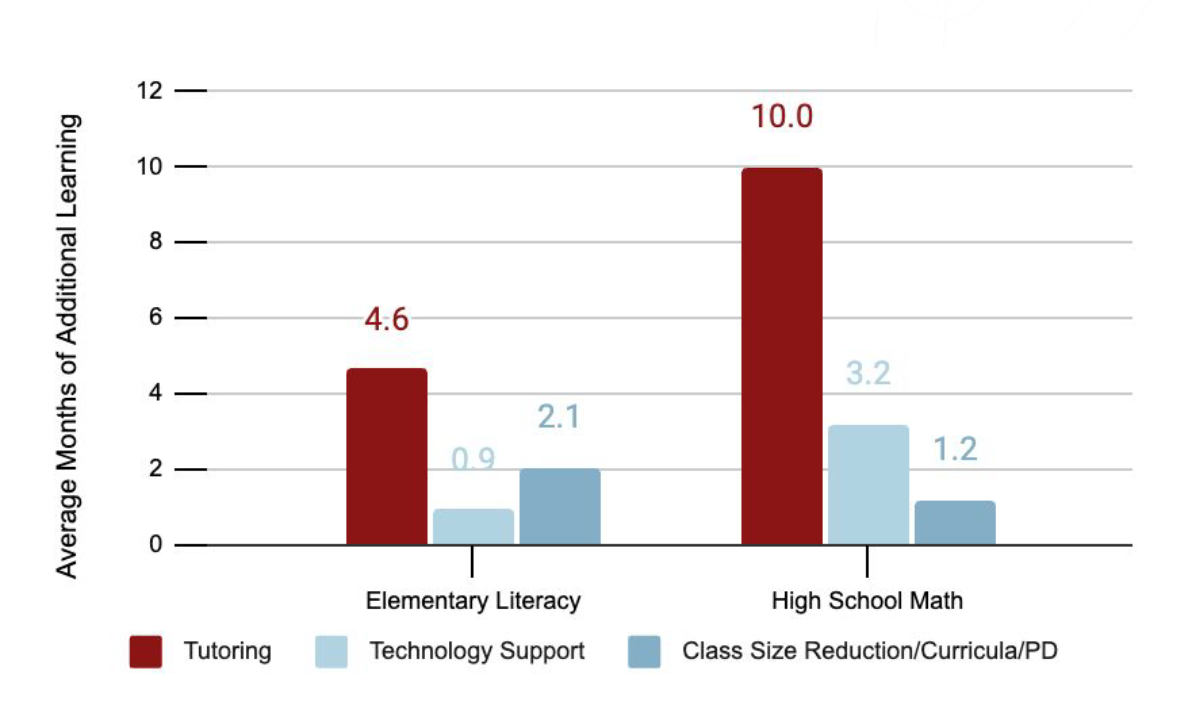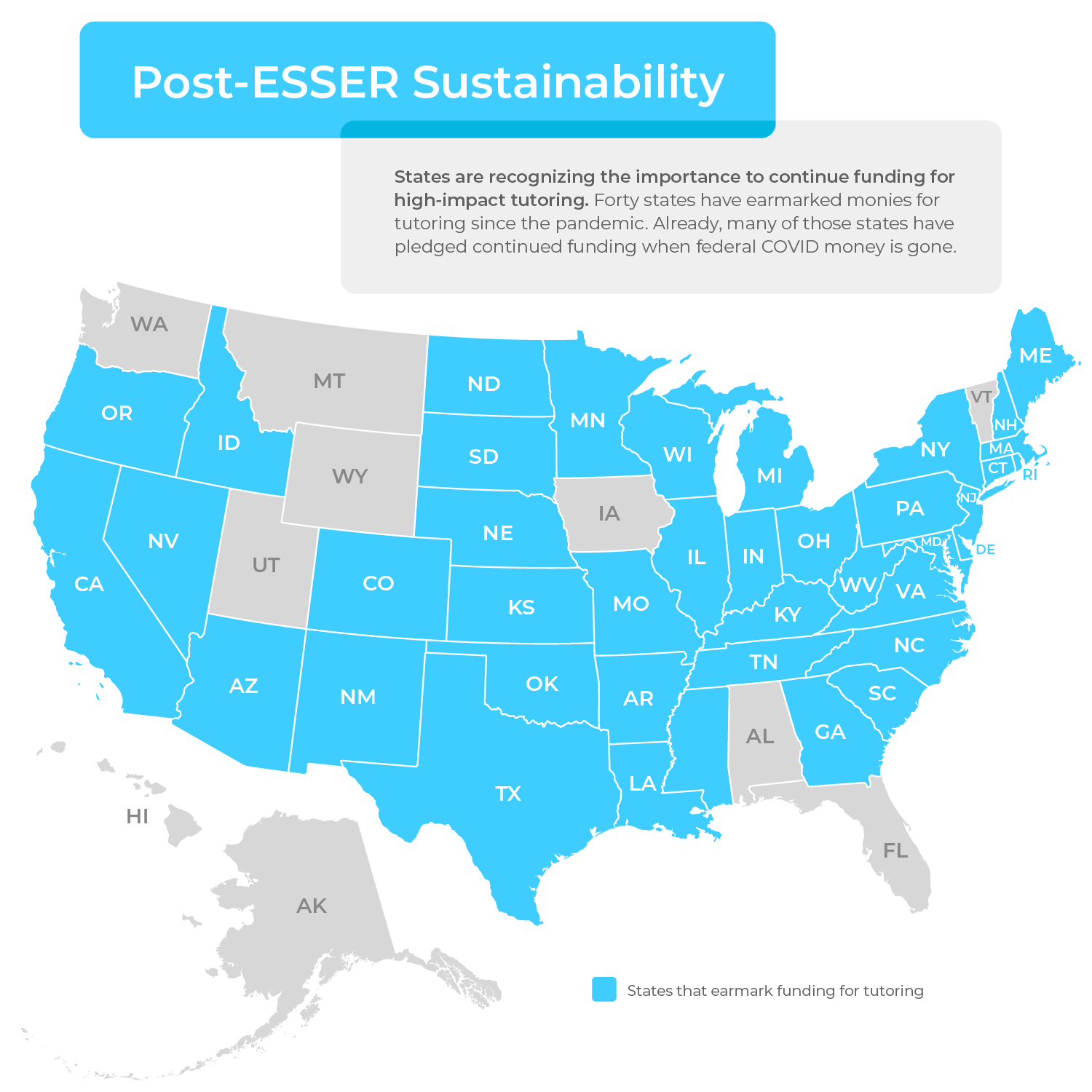Share this
Tutoring: K-12 Funding Strategies for District Leaders Post-ESSER
by Connie Warren, M.Ed. on Aug 29, 2024 10:30:00 AM

But what now?
Planning Beyond ESSER – Sustainable Tutoring Program Funding
Planning Beyond ESSER – Sustainable Funding for High-Impact Tutoring Programs
As ESSER funding gradually sunsets, school and district leaders face the challenge of sustaining high-impact tutoring programs that have been vital in bridging learning gaps. The ESSER (Elementary and Secondary School Emergency Relief) funds provided critical support, enabling schools to implement tutoring programs that drove meaningful gains in student performance.
With recent ESSER extension approvals, there’s a crucial opportunity for schools to plan ahead. Here’s how to leverage remaining ESSER funding strategically and explore alternative K-12 funding sources for sustainable, high-impact tutoring programs.
Why High-Impact Tutoring Works: The ESSER Role in Academic Recovery
ESSER funds supported essential academic recovery efforts, with three major funding rounds:
- CARES Act (ESSER I): $13.2 billion (March 2020)
- CRRSA Act (ESSER II): $54.3 billion (December 2020)
- American Rescue Plan (ARP ESSER or ESSER III): $122 billion (March 2021)
High-impact tutoring has emerged as a key intervention, consistently shown to improve student outcomes. According to the National Student Support Accelerator (NSSA), high-impact tutoring—characterized by frequent, relationship-based sessions—yields significant learning gains, as evidenced in over 150 studies.
"Eight meta-analyses including over 150 studies consistently find that intensive, relationship-based, individualized instruction – or high-impact tutoring – results in substantial additional learning for students."
~ NSSA
National Student Support Accelerator

📚 Not all tutoring programs meet the NSSA criteria for being called "high-impact." Visit our website to learn more about BookNook's high-impact tutoring solution.
Extending ESSER Funding: Recent Federal Updates
These extensions, granted under the Tydings Amendment, apply to funds from all three ESSER allocations, including the most recent and largest, ARP ESSER. As of August 2024, Delaware and Puerto Rico have received ESSER-ARP spending extensions, and more states are expected to follow. This additional time is crucial for districts still navigating labor shortages or other challenges that have impacted spending.
K-12 Funding Strategies to Sustain High-Impact Tutoring Programs
- Develop a comprehensive plan to prioritize spending and identify critical needs. Focus on projects that may require extended funding and plan accordingly to ensure these needs are met within allowable timelines.
- Explore a variety of funding sources beyond federal grants, including state funds, local bonds, private grants, and partnerships with non-profit organizations. This diversification reduces reliance on any single funding source and provides financial stability.
- Leverage virtual tutoring platforms like BookNook to extend the reach of existing resources. Technology can help reduce costs associated with in-person tutoring while still delivering high-quality instruction.
- Engage with state and federal lawmakers to advocate for continued or new funding streams dedicated to high-impact tutoring. Providing evidence of success stories and student improvement data can be persuasive in these efforts.
Ensuring Long-Term Success for High-Impact Tutoring Programs
High-impact tutoring has proven to be a vital tool in addressing learning loss and supporting student achievement. As ESSER funds extend but continue to near expiration, proactive post-ESSER planning and seeking alternative Federal Education Grants are crucial to ensuring the long-term sustainability of high-impact tutoring programs in K-12 education.
Many states are already on board, recognizing the impact and importance of high-impact tutoring. Over 40 states and counting have answered the call for a more sustainable solution following ESSER.

For more detailed information and specific guidelines, schools should visit the U.S. Department of Education and their respective State Department of Education websites.
Share this
- January 2026 (1)
- October 2025 (2)
- September 2025 (1)
- August 2025 (1)
- July 2025 (1)
- June 2025 (1)
- April 2025 (2)
- March 2025 (3)
- January 2025 (3)
- December 2024 (1)
- November 2024 (1)
- October 2024 (4)
- September 2024 (2)
- August 2024 (3)
- July 2024 (2)
- June 2024 (4)
- May 2024 (3)
- April 2024 (4)
- March 2024 (4)
- February 2024 (3)
- January 2024 (5)
- December 2023 (3)
- November 2023 (5)
- October 2023 (5)
- September 2023 (5)
- August 2023 (4)
- July 2023 (5)
- June 2023 (8)
- May 2023 (2)
- April 2023 (3)
- March 2023 (4)
- February 2023 (1)
- January 2023 (1)
- November 2022 (1)
- October 2022 (1)
- September 2022 (1)
- August 2022 (1)
- June 2022 (1)
- April 2021 (1)
- March 2021 (1)
- October 2020 (1)
- December 2019 (1)
- November 2019 (1)
- October 2019 (1)
- July 2019 (1)
- January 2019 (1)
- December 2018 (1)
- October 2018 (1)
- August 2018 (1)
- May 2018 (2)
- April 2018 (1)
- March 2018 (2)
- February 2018 (2)